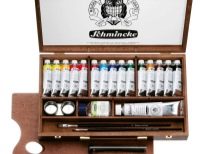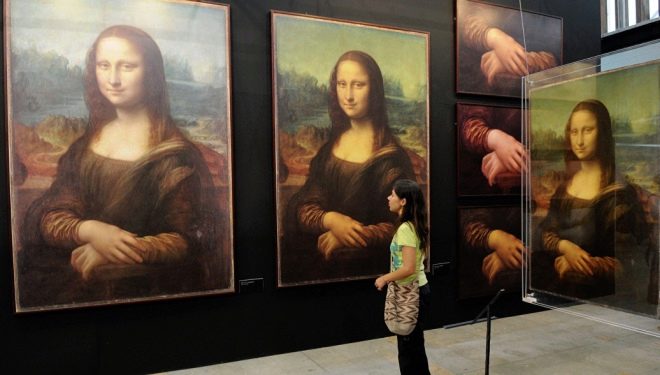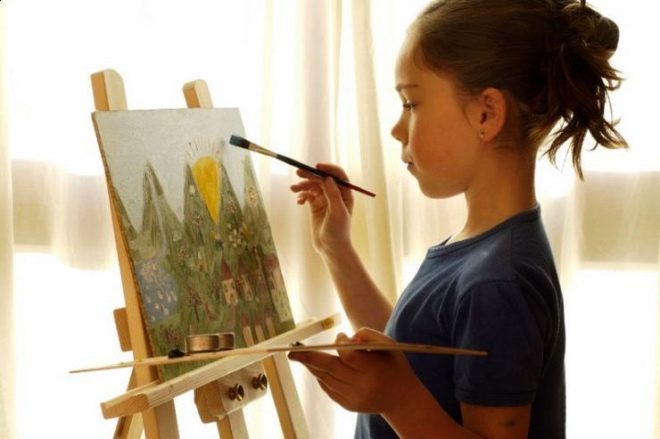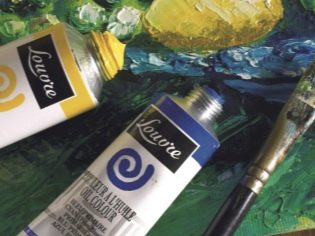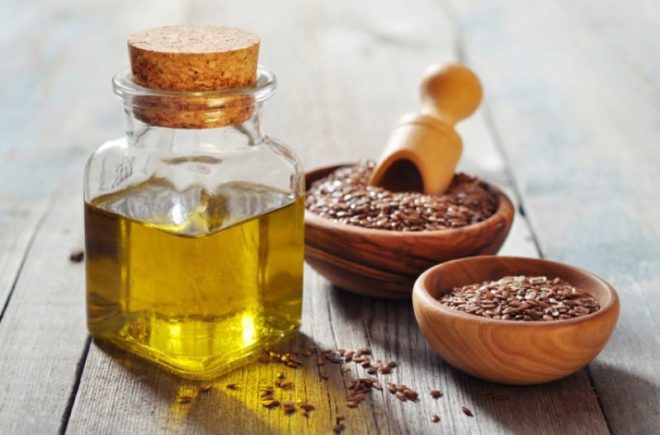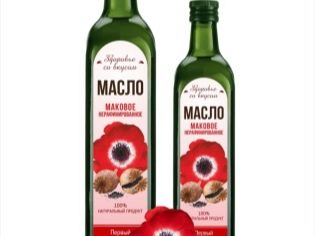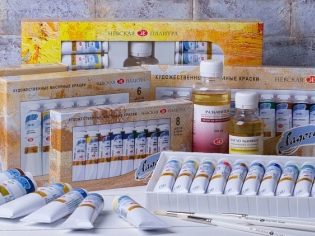Oil paints: varieties of colors and compositions
Drawing with paints and a brush is one of the most popular areas of children's creativity. Kids like this lesson for a bright, aesthetically pleasing result. At the same time, such a hobby contributes to the development of perseverance, attention, color recognition and coordination of movements, not to mention complex thought processes.
Water-based paints — water colors or gouache — are often presented to modern children, and acrylic paints have also become popular in recent years, but real artists of ancient times painted their paintings mostly with oil.
Of course, such a gift would be completely useless to a tiny karapuz, but if the child really loved painting and achieved some success in working with the described types of paints, it makes sense to think about giving oil options.
What it is?
Oil paints are a mixture of fillers, pigments of a certain color, diluted to a liquid state by one or another type of oil (today, flaxseed or walnut is used more often). In modern recipes, additional ingredients can also be used to help the components cohere more closely, speed up the drying, or simply save a little of the expensive pigment.
After applying the dissolved inks, the liquid component is partially absorbed into the base, and partially disappears, due to which only the hardened part remains, which has taken the form that the master has given it.
Due to the high viscosity, the oil for a long time was practically the only option for artists, because in combination with canvas it gave a very reliable and durable image. You can check this fact in any art museum where pictures of centuries-old prescription are exhibited. Oil paints look believable, and also allow you to quite accurately convey the views of the surrounding world, which also played a role.
Previously, artists made paints for themselves, but today they, like any other product for creativity, can be bought. Oil paints are more expensive than minimal children's watercolors and gouaches, so it is logical to sell them, both with multi-color sets and with individual tubes of the desired shade, which allows you to more accurately organize the waste of colors.
It is worth noting that the specifics of oil painting involves the purchase of other consumables, such as solvent, so this hobby is not exactly the cheapest.
For the smallest, oil paints are not exactly suitable - and the drawing procedure is rather complicated, and there is a high risk of poisoning by toxic constituents. Oil painting is not available to everyone. As a rule, only those who devoted a large part of their time to drawing and reached the summits in training reach this level.
Special features
When oil paints appeared, no one can say for sure, but their history goes back several millennia. Traces of using oil-based compositions were found on the Bamiyan Buddha statues in Afghanistan - this sample of painting is considered to be the oldest of all dated ones, and today it has already turned more than 27 centuries old! Thus, the invention does not have any specific historical author - science has not preserved the name of a person,who first guessed using such technology.
In Europe, such paints were also known for a long time, but the large-scale popularization of oil painting, forcing us to talk about such creativity today, is considered the work of the Flemish painter Jan van Eyck, who lived in the distant XV century. Although the technique itself was not invented by him. It is believed that he belongs to the idea of improving oil-based dyes. Thanks to this modernization and the talent of the master, his paintings were radically different from earlier works of other authors. Then realism finally became high enough to be comparable to modern photography.
At that time it was a real revolution in art, therefore, very quickly about the new technique invented by the Flemish, they quickly began talking in neighboring countries - in France and Germany. Despite the poor development of transport at that stage of history, oil technology in a matter of decades reached Italy, where it gave a powerful impetus to such a cultural phenomenon as the Renaissance.
In this era, oil finally became the main tool for the work of the painter, because it was he who wrote almost all the outstanding masterpieces, including the well-known Mona Lisa by Leonardo Da Vinci. Since then, oil painting for almost six centuries has been decisive in the visual arts.
From the end of the last century, oil painting from bohemian art classes began to slowly turn into an amateur hobby, which was promoted both by the increased welfare of the population and the mass orientation to creative hobbies, and the development of new, simplified techniques that allow to paint oil dyes. Today and in our country there is an opportunity for every child to try himself in this kind of art.
Properties
The characteristics of oil paints are ambiguous - on the one hand, it’s not for nothing that they have been in the top for half a millennium, on the other - there are some drawbacks caused by their invention in too old times. So, when applied with a thick layer, they can crack, and the films they form on the canvas are quite easily washed off with water and are afraid of alkaline solutions.
In the Russian reality, the danger is another factor - low temperature. Dried oil paint is afraid of severe frost. At the same time, contemporary artists are trying to find a way out of all these situations. For example, with proper drying, which requires a temperature of 250-300 degrees, the resistance of the film to the effects of weak alkali increases significantly.
The modern color palette of oil paints is much more diverse than that of the old masters. At the same time, such mixtures can be both transparent (used for glazing - applying several translucent shades one on top of the other), and covering, which do not let the bottom tone through. In this case, the first species rather well blend with each other without losing saturation, while the latter usually become gray and become nondescript.
Samples of brightness are those in which there is a high concentration of a single pigment, but because of the toxicity or high cost of some components, the desired color is often obtained by mixing. As a rule, the result is criticized for its reduced saturation, but only in this way can a transparent paint be made on the basis of an opaque pigment, and a correctly calculated combination can sometimes look better than a single-pigmented original.
Pictures painted with such compositions have several unusual properties. In particular, the oil dries up from a week to a half, but the complete polymerization of the upper layer is completed only a couple of years later. At the same time, a completely dry film is very fragile - even a slight deformation is enough to cause it to crack. It is curious that in the process of such a long-term drying, the weight of the picture changes several times, and very noticeably - at first it becomes very heavy, but then it becomes lighter again.
In addition, painting on the basis of linseed oil (which is the most popular ingredient for most paints) deteriorates from storage in the dark - the colors become faded, yellow. But this problem is solved very easily - a masterpiece is restored by a long stay in the sun. You should be careful here, because Some pigments used in the sun quickly burn out.
One solution is the use of refined linseed oil inks, since they are less prone to yellowing, but in this case, the oil cake becomes even more unreliable.
Benefit and harm
Like any other material for creativity, oil paints have their own advantages and disadvantages, which acquire a special shade if they are planned to be used for the creativity of the young user. There are several factors that literally push for the purchase of oil paints for children's painting. These include:
- The relative ease of learning. Here it should be noted that ordinary drawing is more accessible for children in more familiar forms, such as watercolor or gouache. However, the majority of serious artists consider these types of paints unsuitable for real art, and if we talk about painting, they call the oil the easiest to work with.
- Easy mixing colors. Unlike typical children's paints, oil dries very long. Many parents tend to see this as a drawback, but for creativity such a characteristic is a huge plus. The fact is that only with slow drying can you fully pick up the shade, without risking the loss of patience.
- Preservation of shades. Gouache and acrylic paints have been repeatedly criticized by professionals for the fact that their color changes during drying, and this does not allow us to objectively depict reality or fully learn how to draw (the color mixing skill is lost). Oil formulations so long in fashion because of the fact that they do not lose their original shades, and therefore are suitable for modeling, and for the arts.
- The ability to correct errors. When mastering the technique of working with a palette knife, a young artist will always be able to make small changes to his work, simply removing unnecessary paint with the specified tool. Although this technique should not be abused (there is a risk of damage to the canvas). Even a limited ability to edit gives certain opportunities - those that cannot be dreamed of in watercolor technique.
- Long storage. If the child has achieved significant success in painting, then both the parents and he himself will certainly want his best creations to remain as long as possible.
With proper processing and care of oil paintings, they can live for centuries - any serious art exhibition testifies to this.
However, painting is not in vain for a long time was the lot of only persistent professionals. To master even the easiest technique is in fact not easy. The reasons for this are not so few:
- Difficulties in mixing colors. Even such a simple operation, which children should be taught in elementary school, has its own characteristics when working with oil paints. Due to the specificity of the components used, a chemical reaction between the individual components is likely, which will give ordinary dirt instead of the expected shade. Without knowledge of the correct proportions, mixing colors may fail.
- Drying too slow. If you read the biographies of great artists, you can be surprised to note that they worked on some of their masterpieces for months.This is due to the fact that oil paints dry for a long time even in one layer, and when using the glazing technique, the artist has to wait for the previous layer to dry before applying the next one, otherwise the probability of deterioration of shades increases several times.
If the child draws in one layer, this still requires a special room with good ventilation. In addition, there remains an open question regarding the ability of the baby to such amazing perseverance.
- Abundance of toxic components. Few parents would trust children to work with toxic materials, because babies do not monitor compliance with safety regulations. However, it is impossible to avoid this problem when working with oil paints, because many of them initially contain harmful components, for example, the same white lead. Today, many manufacturers advertise their products as completely safe for children, but even if this is true (which still needs to be checked, having carefully studied the composition), this does not eliminate the use of solvents that can be harmful to skin or eyes, and even fumes.
Kinds
If we classify paints on the basis of oil, then first of all, it should be noted that there are:
- oil;
- art paints.
- Paints that are intended for construction and repair needs.
Mutual replacement of some formulations with others is not recommended (even despite some common ingredients)
In general, professional paints are distinguished by higher quality components, which is to the detriment of safety of use, while industrial ones are designed for increased drying speed and application to non-artistic surfaces.
For children's creativity, an improved recipe containing optional elements will be particularly useful. So, special emphasis should be placed on those paints in which there are no harmful components, even if it slightly affects the quality of the picture. It is also possible it makes sense to acquire those options where the formulation is designed for accelerated drying - at the stage of training, the child still does not need an amazing level of quality, if, because of the danger of dyes or too long a process of creation, he abandons training.
Given the increased demand for oil paints on the part of amateurs in recent years, today this product is sold in a wide range. For a child who is just starting his way in oil painting (and it’s still not a fact that it is not this type of paint that will criticize), it is worth buying a minimum set for drawing containing 12 colors.
For the average level, you can pick up a set of 24 colors, significantly expanding the possibilities of mixing shades (no more than three ingredients to get the tone). As for the professionals or very self-confident lovers, they prefer to buy paints in tubes one by one. With constant use, it is cheaper, and in the presence in the immediate vicinity of a large profile shop, it also allows you to more accurately select the desired shades.
Composition
Traditionally, the composition of oil paints includes pigments, an oil base, as well as other additional ingredients to improve qualities, although the latter is not always present.
Pigments are part of the paint in any case, even if it is white, because they are responsible for the presence of shade and its brightness. Both organic and inorganic substances can be used as pigments, however the latter are considered to be of higher quality due to increased durability. The main coloring elements are made of cadmium, cobalt, their salts and compounds, as well as other natural components.
It is advised to choose paints based on expensive pigments, because their shade is more natural, and they can also contain light-resistant elements that allow paintings not to fade in the sun.
For children's creativity, it is recommended to carefully avoid components based on toxic compounds, such as lead white.
Linseed oil is considered the most common base for oil paints, however, due to its light golden color, it is completely unsuitable for the lightest shades in which colorless poppy oil is often used. Another common alternative is walnut oil. Paradoxically but Many of the children's oil paints are actually water-based, although oil is, of course, also present there.
Dry oil paints containing only pigment are also produced. In this case, the consumer mixes it with oil.
Supplemental ingredients are usually designed to replace expensive pigments. As such additives are mica, talc or kaolin. Lead, cobalt or manganese salts help to speed up the drying process of the paint layer, but also increase the risk of cracking and the danger from the use of lead components. Additives can also be used for a higher level of interaction between all the named elements.
Firms
When choosing oil paints, the brand that produces products is of great importance - this is the only way to determine how much a quality product is bought, how safe and suitable it is for proper child education:
- If we are talking about choosing the very first set, and there is no confidence in the stable and long-term use of oil paints, it is better to buy products "Gamma". Such products can hardly be called professional, but this brand is widely known in our country for a huge range of products for children's creativity, and also leaves hope for a safe chemical composition.
- Level up are other domestic brands, for example, "Ladoga" and "Sonnet", and the latter are generally successful even among emerging artists.
- Almost all of the well-known foreign brands are suitable for children, unless they are designed for professionals. In our country, among the imported oil paints, the most popular products of the brand Rembrandt.
Colors
The palette of oil paints is wide enough so that you can choose the right shade for children's creativity, especially since many manufacturers produce not only sets, but also individual tubes. In the latter case, the packages must have the names of the colors.
The main black and white colors use natural metallic components as pigments. Zinc, titanium and lead are used as whitewash (the latter is very harmful), carbon black and graphite are used as blacks, and powder of various metals is used to give metallic shades to paints.
Many shades are based on earth pigments. Brown dye is obtained on the basis of clay umber, and the dye of gold color is sienna (iron oxide hydrate with impurities) or ocher. The remaining oil-based options, such as bright red, blue, turquoise or pink inks, are obtained either by using other inorganic pigments, or by mixing them, or by adding organic dyes.
Which is better to choose?
Choosing children's oil paints should be repelled by a number of criteria that will help protect the baby from the harmful effects and interest him in the painting process.
First of all, you need to carefully examine the composition - there should be nothing in it that could be harmful. In the case of children, it does not matter how this ingredient could get into the body - it simply should not be in the composition, because the child is unlikely to clearly follow the rules of behavior with a dangerous substance.
Not bad, if the manufacturer himself in one way or another indicates that these paints do not contain hazardous components and are acceptable for use by children.
In addition, the starter oil should be as easy to use as possible. Particularly welcome if the manufacturer is not too lazy to accompany your product with instructions on which solvents and lacquers best interact with these paints, and in what conditions they need to be dried. All necessary additions and drying methods should be available to the buyer, otherwise even the most detailed instructions will be useless.
It is very good if siccatives (drying accelerators) are introduced into the composition of children's oil paints. This will help to achieve readiness of the result in a much shorter time, which is very important for two reasons at once:
- First, the child is unlikely to have his own studio to fully engage in painting, and it’s not very convenient to dry the paintings at home for weeks.
- Secondly, the kid may lose all interest in drawing due to the fact that the result of hard work will have to wait too long.
If we talk about specific manufacturers that would meet all the stated requirements, then the ideal candidate for the role of the first oil paints is the products of the Moscow-based company Gamma.
In the case when a child learns under the guidance of an experienced master, and has reached a certain level, he will no longer have to choose the paint - they will either be advised by the teacher, or the kid himself will choose.
Application
Oil painting is very difficult not only as an art, but also as a long process of preparing to paint a picture. The choice of the future basis is rather difficult, since you need to write mainly on canvas, less often wood or cardboard is used, but other materials are unsuitable for such purposes. In this case, even the described surfaces must first be primed, and not in one layer, but in approximately 4-5.
The primer is usually able to draw oil from paints, which does not help preserve the brightness of shades, so that after priming the canvas must also be smeared with a thin layer of linseed oil or with special glue produced specifically for this purpose.
The breadth of creative possibilities in oil painting is clearly visible in the field of choosing the actual tool for application, since there are practically no limitations here. For rough work, brushes from natural bristles of the same pig are used, for drawing thin details - from a soft wool column, synthetic is also appropriate. However, the set of tools does not end there either, because today many authors even draw with a palette knife, and the famous Titian painted fingers at all!
Another thing is that repeating the trick of the famous Italian is clearly not worth it - in oil paints come across toxic components that can penetrate the body through the skin.
To get the perfect shade, different colors from the set need to be diluted with a palette knife on a special palette, but this is not so simple.
The composition of oil paints include a huge number of various components, so there is always a risk of the origin of the chemical reaction between the components. For this reason, each shade is recommended to get a shorter way, mixing no more than three colors at a time.
As a palette, you can choose something from a rather wide range of materials - an ordinary wood plank, wax-impregnated paper, and modern materials, such as a piece of glass or ceramic tile, will do. Masters indicate that Glass "palettes" are the most practical, because they are easy to clean, and the paint does not pull oil, and allow you to put under them the fabric of the color of the soil, giving the opportunity to perfectly match the shade.
When working with oil can not do without a solvent that is needed to dilute the paint, and to wash tools after work. Turpentine is considered to be the best solvent for oil formulations, but any other analog is suitable, as long as it evaporates in full and does not leave any impurities.
It should be remembered that Oil paint should not be very thin, because it sticks to the base precisely because of its thickness. In order not to overdo it with a solvent, in such cases a little linseed oil is simply added to the dye.
The used solvent can be used repeatedly, but only if it is stored in a special jar with a double bottom, the inner one of which should be provided with holes for sedimentation of dissolved pigments.
But do not overestimate the possibilities of the solvent - it will remove not too much paint from the brush, so it is better to wipe the last with a cloth
A separate topic is the use of lacquers and resins, which make it possible to give the oil paints a shine originally uncharacteristic for them. With its aesthetic effect, they somewhat interfere with the formation of a protective film, therefore in the coloring mixture there should be no more than 10%.
For such varnishes, a separate solvent is needed, and only that one is able to dissolve it completely (in order to avoid precipitation). Varnish (more often - ketone) protects the surface of an already finished picture, which allows it to be less exposed to the destructive influence of the environment.
The chemical composition of modern oil paints is often improved in order to influence the drying rate. Often, of course, developers are striving to speed up this process, because not everyone has the conditions that allow up to two weeks to expect complete drying of the masterpiece. but The use of such paints represents a certain risk, since on average they are much more susceptible to cracking.
Slowing down the drying is less popular, however, this effect is needed - it is necessary for those artists who work in the technique of "Alla Prima", which involves the creation of a picture in one session (without interruption of drying).
Reviews
Parental comments on oil paints are usually restrained - the overwhelming majority of the older generation still thinks that such a passion is not very suitable for children. Oil painting is criticized for the high level of toxicity of paints, too high requirements for the conditions of writing pictures, as well as the excessive duration of the creation of a drawing, making the majority of children lose interest in the process.
Positive criticism can be found on the part of those parents who themselves are happy to draw. They note that early oil painting classes contribute to the overall development of the child, and also give much higher guarantees that with time he will become a real serious artist. As a rule, only these parents can choose the right type of paint, so they rarely criticize the purchased for improper quality.
Master class on mixing oil paints, see the following video.




